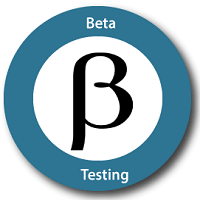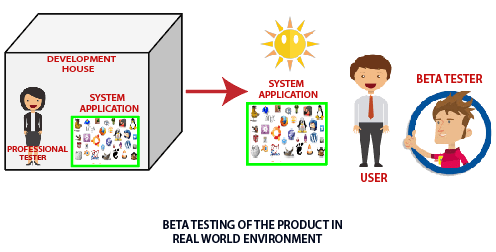Introduction of testing

If we compare the various activity performed to develop ideal software, we will find the importance of software testing similar to that of the software development process. Testing is one of those activities which ensure the accuracy of the development process while validating its functionality and performance.
What is Beta Testing?
Beta testing is a type of User Acceptance Testing among the most crucial testing, which performed before the release of the software. Beta Testing is a type of Field Test. This testing performs at the end of the software testing life cycle. This type of testing can be considered as external user acceptance testing. It is a type of salient testing. Real users perform this testing. This testing executed after the alpha testing. In this the new version, beta testing is released to a limited audience to check the accessibility, usability, and functionality, and more.
- Beta testing is the last phase of the testing, which is carried out at the client's or customer's site.

What are the features of beta testing?
Testing of the product performs by the real users of the software application in the real environment. Beta version of the software is released to a restricted number of end-users to obtain the feedback of the product quality. Beta testing reduces the risk of failure and provides the quality of the product through customer validation. It is the final testing before shipping the product to the customers. Beta testing obtains direct feedback from the customers. It helps in testing to test the product in the customer's environment.
Features of beta testing are:
- Beta testing used in a real environment at the user's site. Beta testing helps in providing the actual position of the quality.
- Testing performed by the client, stakeholder, and end-user.
- Beta testing always is done after the alpha testing, and before releasing it into the market.
- Beta testing is black-box testing.
- Beta testing performs in the absence of tester and the presence of real users
- Beta testing is performed after alpha testing and before the release of the final product.
- Beta testing generally is done for testing software products like utilities, operating systems, and applications, etc.
What is a beta version of the software?
The beta version of the software is delivered to a restricted number of users to accept their feedback and suggestions on quality improvement. Hence, there are two types of beta version:
1) Closed beta version: Closed beta version, also known as a private beta, it is released to a group of selected and invited people. Those people will test the software and evaluate their features and specifications. This beta version represents the software which is capable of delivering value, but it is not ready to be used by everyone. Because it shows the issues like lack of documentation or missing vital features.

2) Open beta version: Open beta is also known as a public beta. The open beta opened to the public. Any user as a tester can assess the beta version to provide the relevant feedback and reviews. Open beta version improves the quality of the final release. This version helps to find the various undetected errors and issues.

The beta testing process orients this beta version.
What is the lifecycle of Beta Testing?
A group of end-users performs beta testing. This process can't execute without any strategy or test plan. Before the testers, the end-user executes this type of testing.
The process of beta testing follows the following steps:
- Planning: Like another testing process, beta testing also supports proper planning. In this stage, the team prepares a testing strategy and defines the goal of testing. In this case, the team establishes the need of users for testing, duration, and necessary details related to the process.
- Participant Recruitment: This is the second stage of the beta process in which the team recruits a group of selected end-users for testing. This group can change as per the requirement of the organization and the product.
- Product Launch: When a team of users (testers) recruited. The beta version of the product is launched or installed at the client or user side, and users will test the product for quality assurance.
- Collect and Evaluate Feedback: When the testing finished, developers will collect the feedback provided by the testers and evaluate it. In the end, based on the feedback, issues, and bugs are fixed and resolved by the responsible individual team.
- Closure: When all the problems fixed and the organization meets the exit criteria, beta testing achieved, and the rewards offered to the testing team.
What are the types of beta testing?
Beta testing has six types. Each type has different aspects of the software. All these help developers to improve the quality of the software and allow them to deliver a product that offers excellent user experience. Here are the different types of beta testing:
- Open Beta Testing: Open beta testing involves testing the software product by a large number of people before the final release. The organization decides to make a software product open to the public before releasing the product. Open Beta includes the extensive participation of the public to use and evaluate software product accordingly.
Users report the bug to the organization, along with a suggestion to improve the quality of the software. - Closed Beta Testing: Opposite to the open beta testing. Closed beta testing performed by the selective and limited number of persons. The organization recruits these. In this testing software product is not open to the public.
- Traditional Beta Testing: In this testing, a software product delivered to the target market, and the feedback from the users collected. This type of testing assistance the beta testing, the quality of the software is improved, and developers can make the changes.
- Public Beta Testing: This type of testing is similar to open testing. Public beta testing also allows the product is delivering to the end-users worldwide, with the aid of various online channels available in the world. From this, the feedback and evaluated data also collected and based on the requirement changes, and the development team implements modifications.
- Technical Beta Testing: Technical beta testing is also an essential type of beta testing. This testing involves delivering the software product to the internal groups of the organization. However, the data and feedback provided by the employees of the organization.
- Focused Beta Testing: This type of testing focused on monitoring and evaluating a specific feature or component of the software. In focused beta testing, the software released to the market and user's experience assessed and collected to make the required changes.
- Post-Release Beta Testing: In this testing, the product delivered to the market for the use of the end-users. Their feedback, reactions, and experience are collect for the future release of the software.
When to perform Beta Testing?
Acceptance testing is the final phase of the testing, which combines both alpha and beta testing to ensure that the product released flawlessly. Beta testing performed at the user's end. This testing always performed after the alpha testing, but before the product released to the market. In this stage, the product is expected to be 90% to 95% completed.
Any product undergoing to beta test should be reviewed for the entire checklist before launching it.
Some of them are:
- All the component of the product is ready to start this testing.
- Documentation which is going to end-user should be kept ready - Setup, installation, usage, Uninstallation should be in detail.
- The product management team should review that all the functionality is in good condition.
- Procedure to collect bugs, feedback, etc. should be identified before publishing it.
What are the stakeholders and participants in the Beta Testing?
The product management, quality management, and user experience teams are the stakeholder in beta testing, and they closely monitor every move of the phase.
The real users who use the product are the participants.
Beta test strategy
- Business objective for the product.
- Beta test plan
- The testing approach followed by participants.
- Tools used to detect bugs, measure productivity, collect feedback.
- When and how to end this testing phase?
What is a Beta Test plan?
A beta test plan can be written in many ways,
Objective: We should have to mention the aim of the project why there is a need for beta testing even after performing the internal testing.
Scope: In this plan, we should mention the areas to be tested or not.
Test Approach: We should have to mention clearly that the testing is in the deep, what to focus on - functionality, UI, response, etc.
Schedule: We have to specify, clearly the start and ending date with time, number of cycles, and duration per cycle.
Tools: Bug logging tools and the usage of the machines should identify.
Budget: Incentive of the bugs based on the severity.
Feedback: Collecting feedback and evaluating methods.
- Identify and review the entry and exit criteria.
What are the entry criteria for Beta Testing?
- Sign off the document from alpha testing.
- Beta version of the software should ready.
- The environment should be ready to release the software application to the public.
- To capture the real-time faults environment should be ready.
What are the exit criteria for Beta Testing?
- All the major and minor issues resolved.
- The feedback report should prepare.
- The delivery of beta test summary report.
What are the advantages of Beta Testing?
Beta testing performed at the end of the software testing lifecycle. Beta testing offers numerous benefits to testers, software developer, as well as the users. In the assistance of this type of testing, it enables developers, testers to test the product before its release in the market. The
- Beta testing focuses on the customer's satisfaction.
- It helps to reduce the risk of product failure via user validations.
- Beta testing helps to get direct feedback from users.
- It helps to detect the defect and issues in the system, which is overlooked and undetected by the team of software testers.
- Beta testing helps the user to install, test, and send feedback regarding the developed software.
What are the disadvantages of Beta Testing?
Disadvantages of beta testing is:
- In this type of testing, a software engineer has no control over the process of the testing, as the users in the real-world environment perform it.
- This testing can be a time-consuming process and can delay the final release of the product.
- Beta testing does not test the functionality of the software in depth as software still in development.
- It is a waste of time and money to work on the feedback of the users who do not use the software themselves properly.
Wrap Up
Keeping in mind the characteristics of beta testing can be concluded that beta testing may be considered desirable for the organization. Beta testing provides the feedback of the real-users, which helps improve the software quality before the product released in the market.



0 Comments